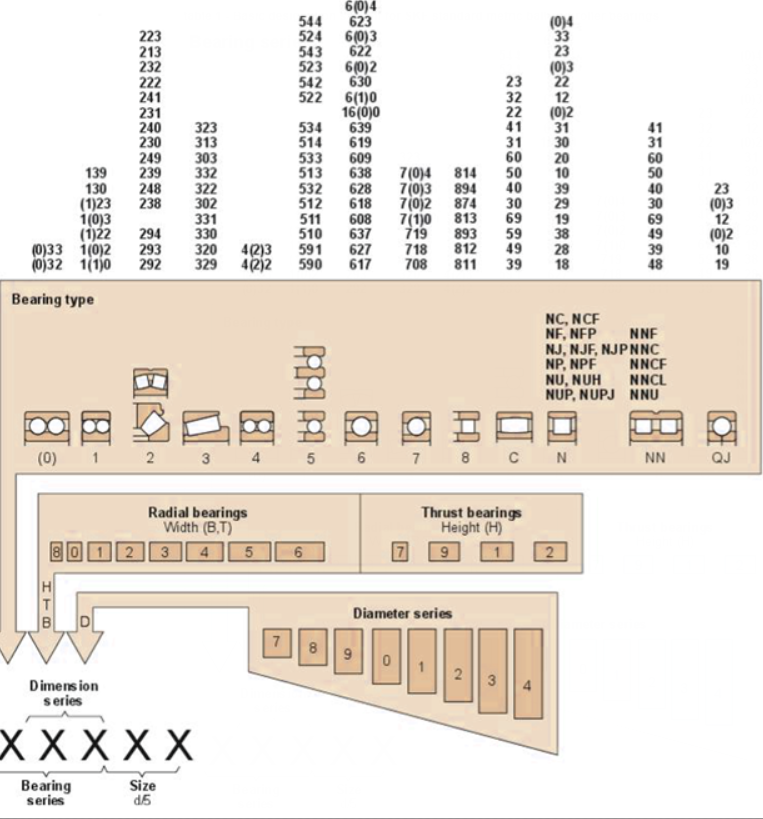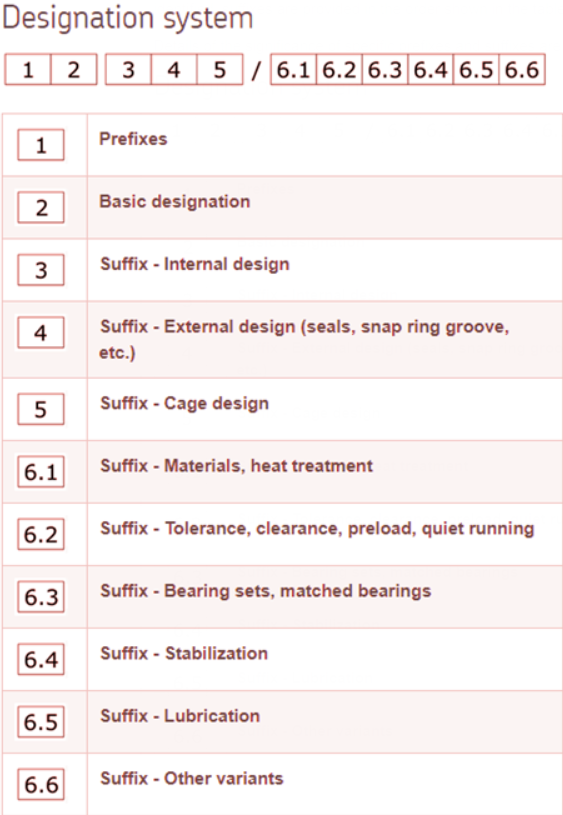Bearing dimensions and designations
Bearing dimensions and designations
Bearing dimensions:
A basic designation typically contains three to five digits. The basic designation system . The number and letter combinations have the following meaning: he first digit indicates the width or height series (dimensions B, T or H). The second digit identifies the diameter series (dimension D).
The first digit or letter or combination of letters identifies the bearing type and eventually a basic variant. The size of a bearing has to be known for its installation on a shaft and in a housing. This is determined by the dimensions of the outer geometry of the bearing and includes:
Diameter of the bearing bore d
Outer diameter D Nominal width Height of the bearing T

0 Double row angular contact ball bearing
Prefixes and suffixes identify design features or bearing components.
Pronunciation of the basic designation
 The summary of the digits within the basic type should follow the breakdown of the bearing
The summary of the digits within the basic type should follow the breakdown of the bearing
designation. The digit groups of the dimension series and bore code should be separated.
Designation system
Prefixes
Basic designation
Suffix – Internal design
Suffix – External design (seals, snap ring groove, etc.)
Suffix – Cage design
Suffix – Materials, heat treatment
Suffix – Tolerance, clearance, preload, quiet running
Suffix – Bearing sets, matched bearings
Suffix – Stabilization
Suffix – Lubrication
Suffix – Other variants
Basic designation
Suffix – Internal design
Composition of Bearing Designations
The last two digits of the basic designation identify the size code of the bearing bore. The size code multiplied by 5 gives the bore diameter (d) in mm.
The most important exceptions in the basic bearing designation system are:
In a few cases the digit for the bearing type or the first digit of the dimension series identification is omitted. These digits are shown in brackets in table 1.
Bearings with a bore diameter of 10, 12, 15 or 17 mm have the following size code identifications:
00 = 10 mm
01 = 12 mm
02 = 15 mm
03 = 17 mm
For bearings with a bore diameter < 10 mm, or ≥ 500 mm, the bore diameter is generally given in millimetres (uncoded). The size identification is separated from the rest of the bearing designation by an oblique stroke, e.g. 618/8 (d = 8 mm) or 511/530 (d = 530 mm). This is also true for standard bearings in accordance with ISO 15 that have a bore diameter of 22, 28 or 32 mm, e.g. 62/22 (d = 22 mm).
For some bearings with a bore diameter < 10 mm, such as deep groove, self-aligning and angular contact ball bearings, the bore diameter is also given in millimetres (uncoded) but is not separated from the series designation by an oblique stroke, e.g. 629 or 129 (d = 9 mm).
Bore diameters that deviate from the standard bore diameter of a bearing are uncoded and given in millimetres up to three decimal places. This bore diameter identification is part of the basic designation and is separated from the basic designation by an oblique stroke, e.g. 6202/15.875 (d = 15,875 mm = 5/8 in).
Bearing series
Bearing series designations consist of an identification for the bearing type and the dimension series. The most common series designations are shown . The digits in brackets belong to the system, but are not used in the series designation in practice.
Prefixes and suffixes
The designations of most SKF rolling bearings follow a system that consists of a basic designation with or without one or more prefixes and/or suffixes, as shown in the table and the examples below.
Prefixes and suffixes provide additional information about the bearing.
Prefixes are mainly used to identify components of a bearing. They can also identify bearing variants.
Suffixes identify designs or variants, which differ in some way from the original design or from the current basic design. The suffixes are divided into groups. When more than one special feature is to be identified, suffixes are provided in the order shown in the table below.
Details of the significance of specific prefixes and suffixes are given in the relevant product sections.
Designation system
Bearing designations not covered by the basic system
Insert bearings
The designations for insert bearings differ somewhat from those described in the basic designation system and are covered in the relevant product section.
Needle roller bearings
The designations for needle roller bearings do not fully follow the basic designation system and are covered in the relevant product section.
Tapered roller bearings
The designations for metric tapered roller bearings follow either the basic designation system or a designation system, established by ISO in 1977, covered in ISO 3551).
Inch tapered roller bearings are designated in accordance with the relevant ANSI/ABMA standard.
Customized bearings
Bearings designed to meet a specific customer requirement are typically designated by a drawing number. The drawing number does not provide any information about the bearing.
Other rolling bearings
Rolling bearings not covered in the Ball bearings and Roller bearings sections, such as super-precision bearings, thin section bearings, slewing bearings or linear bearings, follow designation systems that can differ significantly from the basic designation system.
UCTH213-40J-300 with Setscrew(inch)
CNSORDERNO: Normal-duty(2)
TOGN: UCTH213-40J-300
SDI: B-R1/8
SD: 2 1/2
UCTH212-39J-300 with Setscrew(inch)
CNSORDERNO: Normal-duty(2)
TOGN: UCTH212-39J-300
SDI: B-R1/8
SD: 2 7/16
UCTH212-38J-300 with Setscrew(inch)
CNSORDERNO: Normal-duty(2)
TOGN: UCTH212-38J-300
SDI: B-R1/8
SD: 2 3/8
UCTH212-36J-300 with Setscrew(inch)
CNSORDERNO: Normal-duty(2)
TOGN: UCTH212-36J-300
SDI: B-R1/8
SD: 2 1/4
UCTH211-35J-300 with Setscrew(inch)
CNSORDERNO: Normal-duty(2)
TOGN: UCTH211-35J-300
SDI: B-R1/8
SD: 2 3/16
UCTH211-34J-300 with Setscrew(inch)
CNSORDERNO: Normal-duty(2)
TOGN: UCTH211-34J-300
SDI: B-R1/8
SD: 2 1/8


















